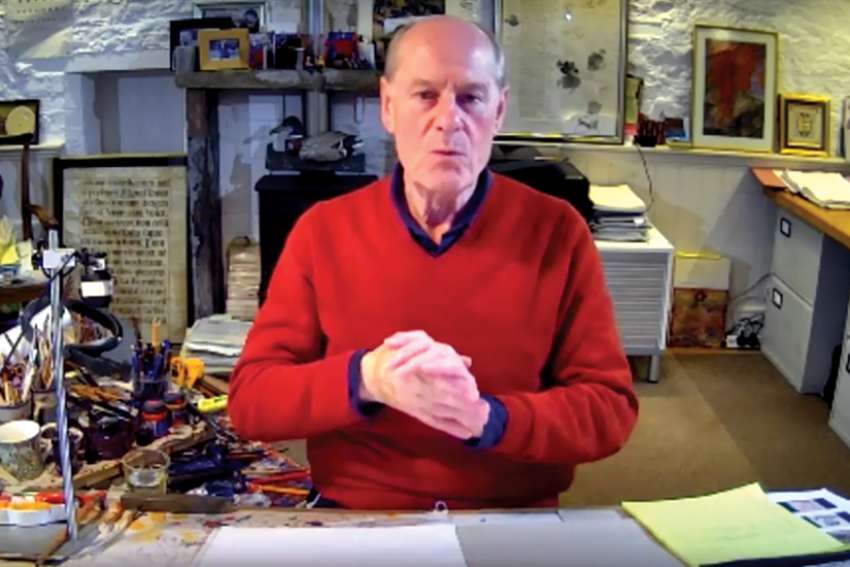“Perfection is not an option,” said Jackson. “We all have to accept that. And did you know doing so helps the writing? It loosens you.”
The 83-year-old Briton — who was commissioned in 1998 by St. John’s Abbey and University in Collegeville, Minnesota, to produce the hand-written, hand-illuminated The Saint John’s Bible — credits this calm, self-accepting temperament as a key to tapping into the entire breadth of his creative arsenal. He shared this insight during a virtual presentation, hosted by Calgary’s St. Mary’s University Nov. 18.
This state of mind, he says, allows him and his fellow artists to transcend to a state where they can effectively tackle a project like The Saint John’s Bible that demands tremendous labour and intricacy.
“You allow yourself to get lost, and that really gives you a big lift and energy to make those marks,” he said. “And those marks can come out really good, and that gives you the energy to go on to the next mark on to the end.”
The Lancashire, England, product is arguably one of the greatest calligraphers in the world. For the first part of his professional life, his curriculum vitae is highlighted by his appointment as a scribe for the Crown Office of the United Kingdom and Northern Ireland. In his mid-20s, Jackson was entrusted with creating official state documents on behalf of Queen Elizabeth II. His service earned him the Royal Victorian Medal in 1985.
While Jackson still serves the Crown, the seminal project that has defined the last quarter century was overseeing the team of scribes who handwrote and illustrated every page of this Bible at the behest of Benedictine monks of St. John’s Abbey.
Jackson treated the virtual audience to an hour-long journey of his creative process. He showcased black-and-white photos of his early life, images of him at work and the vivid illustrations that grace The Saint John’s Bible, housed at the abbey’s Saint John’s Bible Gallery.
As far back as 1970, Jackson made it clear that creating an illuminated Bible would represent the fulfillment of a childhood dream. Ultimately, the timing worked out best for this project to usher Jackson into the new millennium. On Ash Wednesday 2000, March 8, Jackson wrote the first words on a page of vellum (prepared animal skin): “In the beginning was the Word, and the Word was with God, the Word was God ...”
Jackson’s 11-year journey wound up May 9, 2011 when he wrote the final word, “Amen.”
The original may be in Minnesota, but there have been 299 Heritage Editions of the seven-volume set in print, including the one again on display at St. Mary’s art gallery. An opening reception was hosted for the exhibition on Nov. 12. Jackson has shared some of his original sketches when he was first starting on the project.
Moderator Gerry Turcotte, the president and vice chancellor of St. Mary’s University, told The Catholic Register that this event was a “full circle” moment for him.
“The Saint John’s Bible was one of the first initiatives I brought to the university when I was hired in mid-2011,” said Turcotte. “We acquired the volumes in 2012. I had seen the volumes and had seen the potential of the project. I worked with donors to not only bring the Bible (to St. Mary’s), but to also build a program around it.
“I hoped the Bible could be a game changer for the university’s profile and for our teaching across different genres. Beyond sacred texts, it is also a book about bookmaking, about calligraphy and a study of art and community.”
Turcotte, during the presentation, asked Jackson extensively about the collaborative process with the other scribes and the liturgical committee backing this effort. Specifically, how differences in opinion were handled.
“You asked me who won (those disagreements). We all won,” said Jackson. “In the end, they said, ‘you will know what to do.’ That trust had to be earned by them realizing I was truly digging as deep as I could into what they had said was important to include in a way to give back to them in a way they couldn’t have imagined.”
Jackson curtailed plenty of avenues for artistic tension by complementing every design he couriered to his U.S. collaborators with a detailed written description about how he conceived each illustration and why this particular image would align best with the text. Sending an image alone, he says, “there would have been quite a lot of discussion and a myriad of interpretations.”
“But if I explain how I got into it, and how I got there, then, over time, that would cut out a lot of misunderstandings.”

